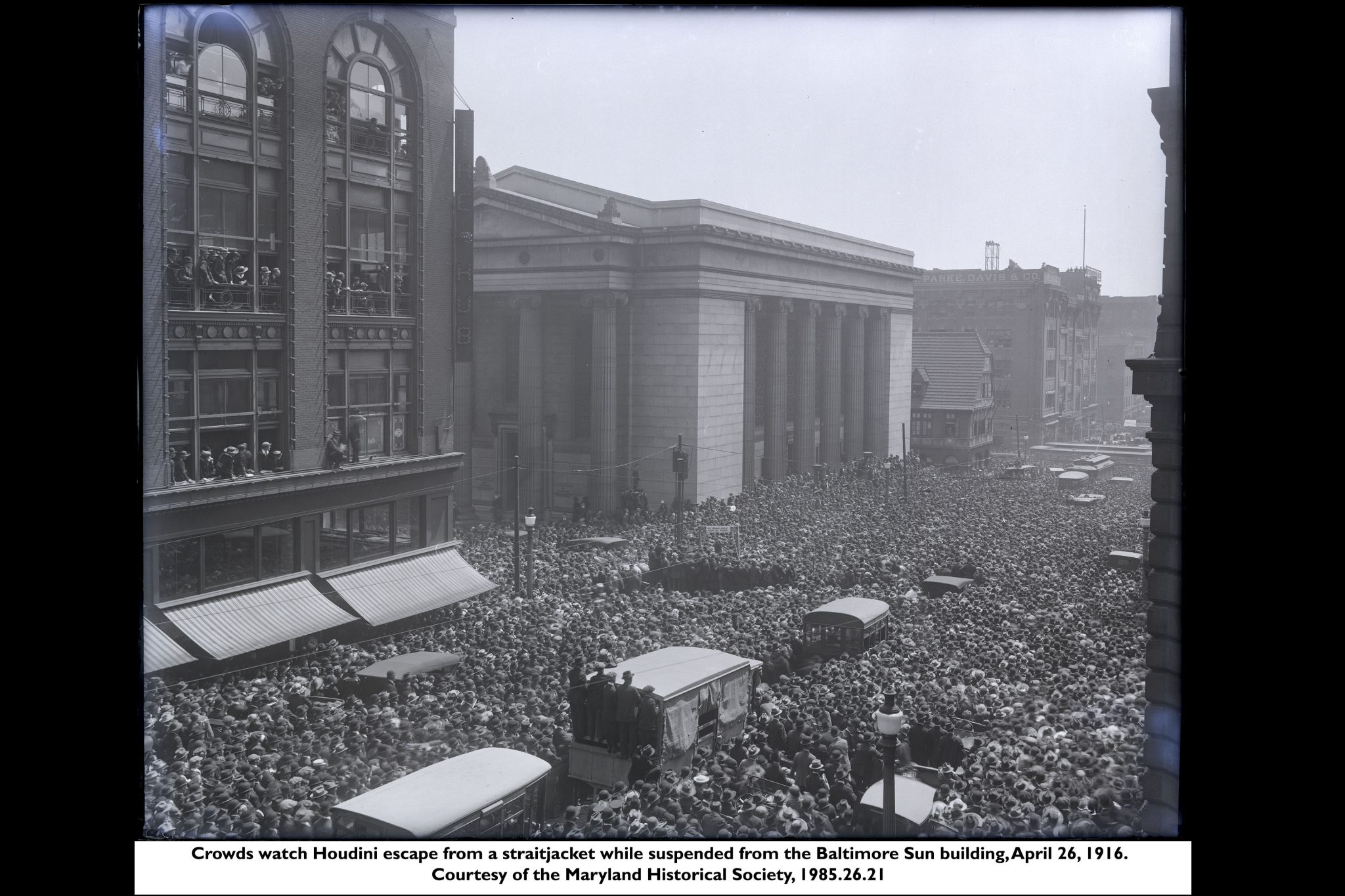Last July, while attending the annual Artscape festival in Baltimore’s Mount Royal neighborhood, Marvin D. Pinkert ducked into the lobby of the Theatre Project to escape the oppressive heat. As fate would have it, he immediately noticed magician and storyteller David London performing for a group there.
Afterward, Pinkert, who is executive director of the Jewish Museum of Maryland, asked London if he knew anything about Jews and magic. “Are you kidding?” London responded. “My bar mitzvah speech was about the intersection of Jews and magic!”
Out of that conversation came the idea for the JMM’s upcoming exhibition, “Inescapable: The Life and Legacy of Harry Houdini.”
“Inescapable,” which opens on June 24, was curated by London and designed by Baltimore-based independent creative consultant Danielle Nekimken. London spent three months collecting Houdini memorabilia and artifacts around the country for the exhibition.
“Normally, it takes about two years to put a show like this together,” says Pinkert. “We did this one in nine months.”
At the exhibition, visitors will be encouraged to experiment with and perform some of Houdini’s most celebrated tricks and illusions, including “The Vanishing Elephant.” (In the JMM version, the 5-ton elephant will be a much smaller toy pachyderm.)
Pinkert says one of the challenges of any depiction of Houdini’s life is separating fact from fiction “because he spent his career creating fictions about himself.”
One of seven children, Houdini was born Erik Weisz in 1874 in the Hungarian capital of Budapest. When he was 4, his family immigrated to the United States, where his father, Rabbi Mayer Samuel Weisz, assumed the pulpit at a congregation in the small Wisconsin city of Appleton. (The exhibition features a Hebrew Bible that once belonged to Houdini’s father.)
While in his early teens, Erik, who became Ehrich Weiss, became obsessed with the world of magic. He began performing for small groups at dime museums and sideshows, went on to become a headliner on the vaudeville circuit and adopted the name Houdini after his idol, French magician Jean-Eugene Robert-Houdin.
He went on to international fame as a master illusionist, stunt performer and self-styled debunker of the era’s spiritualists. In 1926, Houdini died at age 52 of peritonitis due to a ruptured appendix suffered under mysterious circumstances. But his legend has only grown over the decades, the stuff of books, articles, movies and TV miniseries. There are museums dedicated to Houdini in New York, Los Angeles, Budapest, Appleton and Scranton, Pa.
‘A Household Name’
In its six sections, the JMM exhibition, which will run until Jan. 21, 2019, includes photographs, magic tricks, escape artist paraphernalia — featuring Houdini’s handcuffs, picks, locks and even one of his straitjackets — and other artifacts, including a rare recording of the great illusionist’s voice.
“Of course he’s a magician, and that plays prominently throughout the exhibit,” says JMM education director Ilene Dackman-Alon. “But we’re also looking at his life through a Jewish lens, as an immigrant, as a member of a family.”
Also on display will be one of Houdini’s diaries, open to a page in which he chronicles an 1898 tour of Maryland. Pinkert says Houdini performed more than 100 times in the Old Line State, with his most famous appearance in 1916 when an estimated 50,000 people watched him escape from a straitjacket while hanging upside down at the old Sun Square in downtown Baltimore.
“That just couldn’t have happened 30 years earlier,” says Dackman-Alon. “There were a lot of advances in technology during Houdini’s life, from mass-produced and distributed newspapers to streetcars to the technologies, that enabled his tricks. All those things allowed large numbers of people to know about him and get to his performances. It was a combination of technology, skill and charisma that made him a household name.”
The JMM is planning a variety of activities and programs related to “Inescapable,” including living history performances by London as Houdini; talks by authors about the magician and his life; a variety of magic shows; and educational experiences for students. One activity involves students conducting research at the exhibition that culminates in their solving a magic trick.
In his re-enactment performances as Houdini, London says he plans to focus on the man and not the tricks.
“Ehrich Weiss was born; Harry Houdini was created,” London says. “In both the exhibit and in my living history performance, I’m primarily interested in telling their interconnected stories and using magic to enhance that.”
As part of the exhibition’s June 24 opening, the city will close Lloyd Street in front of the museum for an afternoon of festivities. Several nearby museums and cultural institutions — including the National Aquarium, the Reginald F. Lewis Museum of Maryland African American History & Culture, Port Discovery Children’s Museum, the Star-Spangled Banner Flag House, The Associated: Jewish Community Federation of Baltimore and others — will use the occasion to promote the Jonestown neighborhood as a destination point.
In addition, Baltimore-based escape artist Dai Andrews will perform at the “Magic of Jonestown Festival,” suspended upside down from a 50-foot crane, to re-create Houdini’s infamous 1916 Baltimore straitjacket escape.
“It’s a trick I’ve done before,” Andrews says. “When Houdini did this trick, he didn’t want people to be able to see how he did it. That’s the main reason he did it from up in the air rather than at eye level. In 2018, audiences know it’s just about skill but even so, it’s fun to see someone escape from a straitjacket. To add even more fun and to demonstrate even more skill, I’m doing it upside down with handcuffs and chains added.”
Although he won’t use a safety net, Andrews says he will use several professionally trained riggers to do the crane-and-rope work. “I have complete confidence in their abilities,” he says.
Marvin Pinkert says he’s confident that JMM visitors will be thoroughly entertained and enlightened by “Inescapable.”
“Houdini was the first Jewish superstar,” says Pinkert. “I always thought of Houdini as an entertainer, but I’ve discovered that he was a whole lot more. We hope visitors to the exhibit will discover that, too.”
For information, visit jewishmuseummd.org.
Jonathan Shorr is a Baltimore-based freelance writer.





